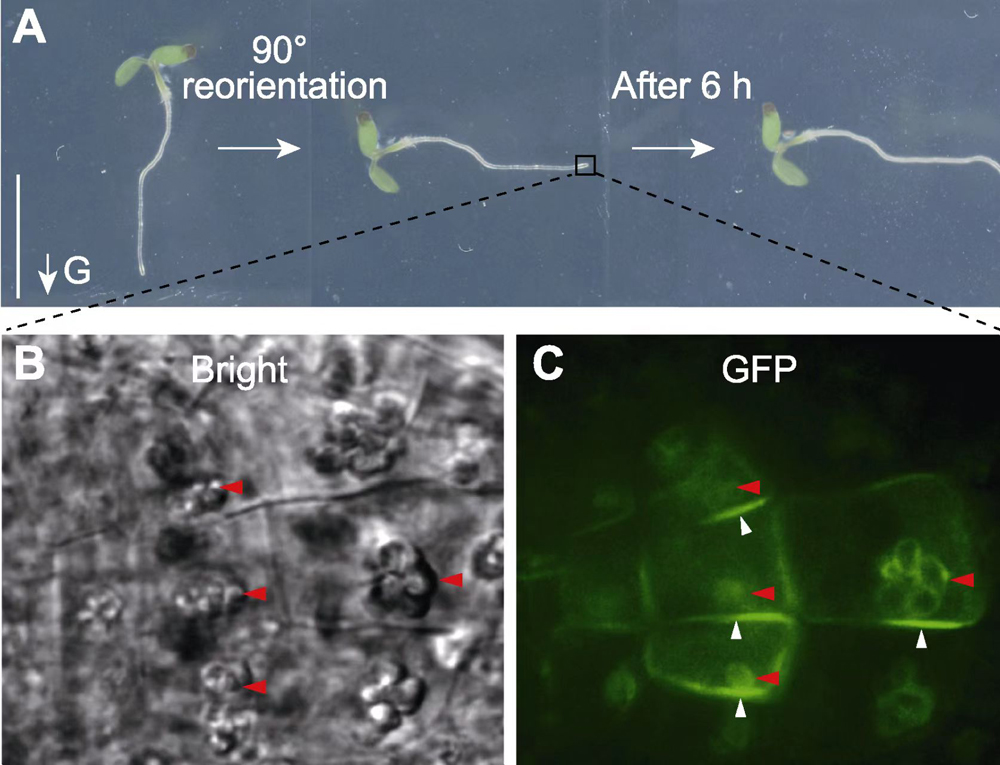

Century-old Hypothesis Finally Revealed: the Shuttling LAZY Proteins “Awaken” Gravity Sensing in Planta
Received date: 2023-09-18
Accepted date: 2023-09-21
Online published: 2023-09-22

Key words: gravitropism; amyloplast; polar localization; phosphorylation; “starch-statolith” hypothesis; LAZY; TOC; MPK
Wang Wenguang , Wang Yonghong . Century-old Hypothesis Finally Revealed: the Shuttling LAZY Proteins “Awaken” Gravity Sensing in Planta[J]. Chinese Bulletin of Botany, 2023 , 58(5) : 677 -681 . DOI: 10.11983/CBB23131
| [1] | Andrès C, Agne B, Kessler F (2010). The TOC complex: preprotein gateway to the chloroplast. Biochim Biophys Acta Bioenerg 1803, 715-723. |
| [2] | Cai YY, Huang LZ, Song YQ, Yuan YD, Xu S, Wang XP, Liang Y, Zhou J, Liu GF, Li JY, Wang WG, Wang YH (2023). LAZY3 interacts with LAZY2 to regulate tiller angle by modulating shoot gravity perception in rice. Plant Biotechnol J 21, 1217-1228. |
| [3] | Chen JY, Yu RB, Li N, Deng ZG, Zhang XX, Zhao YR, Qu CF, Yuan YF, Pan ZX, Zhou YY, Li KL, Wang JJ, Chen ZR, Wang XY, Wang XL, He SN, Dong J, Deng XW, Chen HD (2023). Amyloplast sedimentation repolarizes LAZYs to achieve gravity sensing in plants. Cell 186, 4788-4802. |
| [4] | Chen RJ, Rosen E, Masson PH (1999). Gravitropism in higher plants. Plant Physiol 120, 343-350. |
| [5] | Dong ZB, Jiang C, Chen XY, Zhang T, Ding L, Song WB, Luo HB, Lai JS, Chen HB, Liu RY, Zhang XL, Jin WW (2013). Maize LAZY1 mediates shoot gravitropism and inflorescence development through regulating auxin transport, auxin signaling, and light response. Plant Physiol 163, 1306-1322. |
| [6] | Firn RD, Digby J (1997). Solving the puzzle of gravitropism—has a lost piece been found? Planta 203, 159-163. |
| [7] | Fukaki H, Wysocka-Diller J, Kato T, Fujisawa H, Benfey PN, Tasaka M (1998). Genetic evidence that the endodermis is essential for shoot gravitropism in Arabidopsis thaliana. Plant J 14, 425-430. |
| [8] | Huang LZ, Wang WG, Zhang N, Cai YY, Liang Y, Meng XB, Yuan YD, Li JY, Wu DX, Wang YH (2021). LAZY2 controls rice tiller angle through regulating starch biosynthesis in gravity-sensing cells. New Phytol 231, 1073-1087. |
| [9] | Kubis S, Patel R, Combe J, Beédard J, Kovacheva S, Lilley K, Biehl A, Leister D, Riéos G, Koncz C, Jarvis P (2004). Functional specialization amongst the Arabidopsis Toc159 family of chloroplast protein import receptors. Plant Cell 16, 2059-2077. |
| [10] | Li PJ, Wang YH, Qian Q, Fu ZM, Wang M, Zeng DL, Li BH, Wang XJ, Li JY (2007). LAZY1 controls rice shoot gravitropism through regulating polar auxin transport. Cell Res 17, 402-410. |
| [11] | Li YF, Deng ZG, Kamisugi Y, Chen ZR, Wang JJ, Han X, Wei YX, He H, Terzaghi W, Cove DJ, Cuming AC, Chen HD (2021). A minus-end directed kinesin motor directs gravitropism in Physcomitrella patens. Nat Commun 12, 4470. |
| [12] | Morita MT, Tasaka M (2004). Gravity sensing and signaling. Curr Opin Plant Biol 7, 712-718. |
| [13] | Nishimura T, Mori S, Shikata H, Nakamura M, Hashiguchi Y, Abe Y, Hagihara T, Yoshikawa HY, Toyota M, Higaki T, Morita MT (2023). Cell polarity linked to gravity sensing is generated by LZY translocation from statoliths to the plasma membrane. Science 381, 1006-1010. |
| [14] | Periappuram C, Steinhauer L, Barton DL, Taylor DC, Chatson B, Zou JT (2000). The plastidic phosphoglucomutase from Arabidopsis. A reversible enzyme reaction with an important role in metabolic control. Plant Physiol 122, 1193-1199. |
| [15] | Stanga JP, Boonsirichai K, Sedbrook JC, Otegui MS, Masson PH (2009). A role for the TOC complex in Arabidopsis root gravitropism. Plant Physiol 149, 1896-1905. |
| [16] | Strohm AK, Baldwin KL, Masson PH (2012). Multiple roles for membrane-associated protein trafficking and signaling in gravitropism. Front Plant Sci 3, 274. |
| [17] | Strohm AK, Barrett-Wilt GA, Masson PH (2014). A functional TOC complex contributes to gravity signal transduction in Arabidopsis. Front Plant Sci 5, 148. |
| [18] | Taniguchi M, Furutani M, Nishimura T, Nakamura M, Fushita T, Iijima K, Baba K, Tanaka H, Toyota M, Tasaka M, Morita MT (2017). The Arabidopsis LAZY1 family plays a key role in gravity signaling within statocytes and in branch angle control of roots and shoots. Plant Cell 29, 1984-1999. |
| [19] | Volkmann D, Baluska F (2006). Gravity: one of the driving forces for evolution. Protoplasma 229, 143-148. |
| [20] | Wang WG, Gao HB, Liang Y, Li JY, Wang YH (2022). Molecular basis underlying rice tiller angle: current progress and future perspectives. Mol Plant 15, 125-137. |
| [21] | Wang XY, Yu RB, Wang JJ, Lin ZC, Han X, Deng ZG, Fan LM, He H, Deng XW, Chen HD (2020). The asymmetric expression of SAUR genes mediated by ARF7/19 promotes the gravitropism and phototropism of plant hypocotyls. Cell Rep 31, 107529. |
| [22] | Went FW, Thimann KV (1937). Phytohormones. New York: The macmillan company. |
| [23] | Yang PY, Wen QM, Yu RB, Han X, Deng XW, Chen HD (2020). Light modulates the gravitropic responses through organ-specific PIFs and HY5 regulation of LAZY4 expression in Arabidopsis. Proc Natl Acad Sci USA 117, 18840-18848. |
| [24] | Yoshihara T, Iino M (2007). Identification of the gravitropism-related rice gene LAZY1 and elucidation of LAZY1- dependent and -independent gravity signaling pathways. Plant Cell Physiol 48, 678-688. |
| [25] | Yoshihara T, Spalding EP (2017). LAZY genes mediate the effects of gravity on auxin gradients and plant architecture. Plant Physiol 175, 959-969. |
| [26] | Yu TS, Lue WL, Wang SM, Chen J (2000). Mutation of Arabidopsis plastid phosphoglucose isomerase affects leaf starch synthesis and floral initiation. Plant Physiol 123, 319-326. |
/
| 〈 |
|
〉 |